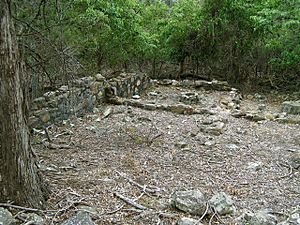Bittangabee Bay facts for kids
Bittangabee Bay is a small, beautiful bay in New South Wales, Australia. You can find it inside Ben Boyd National Park, and there's a camping spot close by. The National Parks and Wildlife Service (NPWS) takes care of the area. You can get there by driving on a dirt road from the Princes Highway. It's a safe place for boats to stop between Twofold Bay and Mallacoota. Many yachts anchor here overnight. Bittangabee Creek flows into the bay.
A Look Back in Time
Bittangabee Bay has a rich history. It was important to the Aboriginal people and also to early European settlers.
The original people of this land, the Thaua (or Yuin) nation, called it 'Pertangerbee'. They have lived here for more than 6,000 years. This bay was a special camping and teaching place for them. Green Cape, nearby, was a teaching area for young men. Naa-chi (now Nadgee Nature Reserve) is where their important Rainbow Serpent rests.
Aboriginal people still have strong connections to this land. The National Park Service works with them to respect their culture. They believe in taking care of this beautiful part of New South Wales.
You can see some old stone ruins near the bay's shore. These ruins are from 1844. For a while, some people thought these ruins might have been built by Portuguese explorers. However, a historian named Michael Pearson later showed that this idea was not correct.
Building Green Cape Lighthouse
Bittangabee Bay played a big role in building the Green Cape Lighthouse. This lighthouse was built in 1881.
The old stone building at Bittangabee Bay was a storage place. Supplies for the lighthouse were left here. Workers would then collect them. This was important until a proper road was built.
Bittangabee Bay was the closest safe spot for ships to anchor near Green Cape Lighthouse. All the building materials and supplies for the lighthouse arrived here by ship. Then, they were moved overland to the lighthouse site.
In 1881, a builder named Albert Aspinall built a wooden jetty and storeroom at Bittangabee Bay. He then spent five months building a seven-kilometre-long wooden track. This track went through the forest to connect Bittangabee with Green Cape. After the track was ready, he could start building the lighthouse tower and the lighthouse keepers' homes. Materials and supplies were pulled from Bittangabee to the lighthouse site on wooden trolleys by horses.


